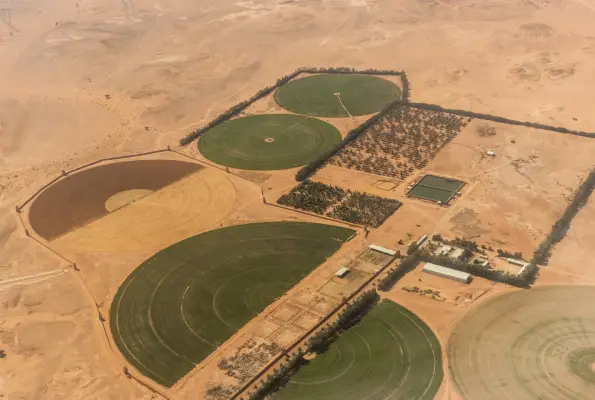The desert is dying. Except it’s not. It’s being reborn now. From Dubai to Riyadh, barren wastelands are transforming into towering food factories. Vertical farms are rising where nothing grew before. This isn’t science fiction. It’s happening right now.
The technology? Revolutionary. The impact? Absolutely futuristic. It’s solving one of humanity’s biggest hurdles and feeding billions on a warming planet with rapidly disappearing farmland. The impossible is becoming routine. It’s the dawn of a new agricultural revolution.
For centuries, desert communities scraped by, herding livestock, mining minerals, and surviving. The land gave little. Hope was scarce. But that era is over.
Vertical farming technology is rewriting the rules. These barren landscapes? They’re becoming food production powerhouses. What seemed impossible is now a reality.
Here’s the breakthrough: instead of spreading crops across endless fields, vertical farms stack them upward in climate-controlled towers. Hydroponics and aeroponics eliminate soil. Plants thrive in nutrient-rich water or mist. Layer upon layer. Controlled. Optimized. Efficient. This isn’t farming. This is a transformation, as it slashes water use.
Water scarcity killed desert agriculture. Traditional farms gulp hundreds of litres to grow a single kilo of tomatoes. Vertical farms, on the other hand, consume just 20 litres. Closed-loop systems recycle every drop. No evaporation. No waste. No runoff. Pure efficiency. Some systems reuse 98% of water. That’s revolutionary for deserts.
Climate control adds the knockout punch, as it comes with elements like perfect temperature, ideal humidity, optimised light, year-round harvests, regardless of scorching heat or season. Extreme weather outside? Irrelevant. Inside, conditions stay perfect. The method also eliminates concerns like pests, diseases, and pesticides.
The results? Staggering. Up to 390 times more yield per square foot than conventional farms. Some operations achieve 240 times the traditional output. Efficiency meets sustainability. Desert dreams become harvest reality.
Explosive Growth And Massive Potential
The Middle East and Africa (MENA) region is leading this revolution. The vertical farming market hit USD 1.15 billion in 2024. By 2025, the milestone reached the USD 1.45 billion mark. Saudi Arabia is going all-in. AeroFarms partnered with the Public Investment Fund (PIF) to build the region’s largest vertical farm in Riyadh. One million kilogrammes of leafy greens are grown annually. That’s called scale.
Innovation is everywhere. Sundrop Farms harnesses solar power to desalinate seawater for irrigation. The UAE operates one of the world’s largest vertical hydroponic farms, a colossal 330,000 square feet, producing a million kilogrammes yearly.
Technology powers it all. IoT (Internet of Things) sensors monitor every plant, assisting in real-time data-driven decisions. LED lights replicate perfect sunlight. Automated systems deliver precise nutrients. Solar energy, abundant in deserts, runs operations off-grid.
Beyond tech, vertical farming creates jobs. Fresh, reliable food stays local, cutting import dependency. Communities that once faced hunger now have access to nutritious produce regularly. Food security improves, while local economies strengthen.
The global market? Projected to hit USD 11.71 billion by 2027. As climate change intensifies and deserts expand, these innovations become critical worldwide. What works in Arabian deserts works everywhere.
The Verdict
Vertical farming isn’t just solving desert food production. It’s redefining what’s possible. By 2050, 80% of humanity will live in cities. Traditional farming can’t feed them all. The land isn’t there. The water isn’t there. But vertical farms? They thrive where conventional agriculture dies.
These towering gardens eliminate pesticides, slash transportation emissions, and create food security in the harshest climates. They’re turning food deserts into food oases. Making fresh produce accessible to communities that have never had it before is crucial for building resilience against climate change.
The technology is effective, the economics are sound, and the impact is measurable. From climate-controlled greenhouses in Dubai to million-kilogramme operations in Riyadh, evidence of success is all around us. This approach is no longer experimental; it is operational, scalable, and essential.
Desert vertical farming showcases humanity’s ingenuity. It tackles impossible challenges, engineers radical solutions, and generates abundance from scarcity. The future isn’t just approaching; it’s already unfolding, one vertical layer at a time. And it’s greener than anyone had envisioned.



